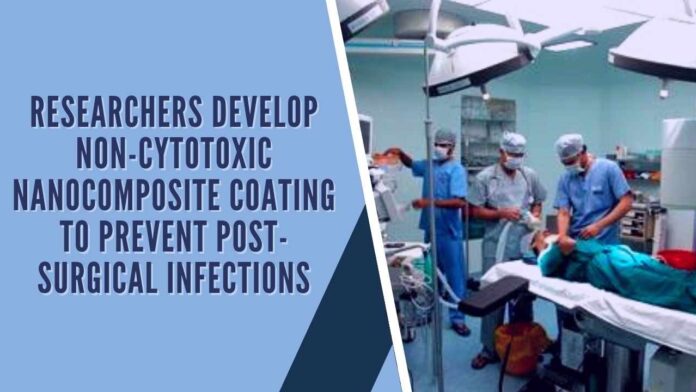
The developed coating not only inhibits biofilm formation by restricting bacterial and water adhesion but also kills attached bacteria
Researchers from the International Advanced Research Centre for Powder Metallurgy and New Materials (ARCI), under the Department of Science and Technology, have developed a nanocomposite coating named ATL by combining water repellence and biocidal properties (combinatorial approach) that exhibits both hydrophobic and biocidal behavior, an official statement said.
The developed coating not only inhibits biofilm formation by restricting bacterial and water adhesion but also kills attached bacteria, it added.
The nanocomposite coating can inhibit biofilm formation and also kill attached bacteria, thereby helping tackle growing post-operative infections, a common occurrence due to antibiotic resistance in bacteria.
ATL was deposited on different surgical sutures made of silk, nylon, and polyglactin 910 (vicryl) in addition to surgical instrument grade stainless steel 420 coupons and tested for biofilm inhibition against American Type Culture Collection (ATCC) and clinical isolate strains of proven biofilm-forming bacteria such as Pseudomonas aeruginosa, Acinetobacter baumanii, Staphylococcus aureus and Escherichia coli at Translational Health Science Technology Institute (THSTI) and L V Prasad Eye Institute (LVPEI), respectively.
These post-operative surgical site infections (SSIs), which according to WHO, affect 11 percent of patients in low and middle-income countries, are caused by the development of biofilms (groups of bacteria growing in formation that are highly resistant to antibiotics) on the incision site or in the soft tissue inside the area.
The biofilm matrix, which may come from existing infections in the patient’s body or can be transferred from the hospital environment through potential carriers like surgical equipment, wound dressing, or bandage/ surgical sutures, acts as a physical shield against antibiotics given during the operation, slowing down their penetration.
The ATL-coated vicryl sutures exhibited higher percentage of biofilm inhibition when compared to commercially available triclosan-coated antibacterial sutures.
[With Inputs from IANS]
PGurus is now on Telegram. Click here to join our channel and stay updated with all the latest news and views
For all the latest updates, download PGurus App.
- Like Amethi, Congress’ ‘shehzada’ will lose Wayanad seat too: PM Modi’s dig at Rahul Gandhi - April 20, 2024
- Karnataka HM apologizes to Neha’s parents while the killer Fayaz’s mother expresses her desire to ‘punish her son’ - April 20, 2024
- US: Indian student’s death possibly linked to Blue Whale suicide game - April 20, 2024











I believe it when it becomes a commercial product.